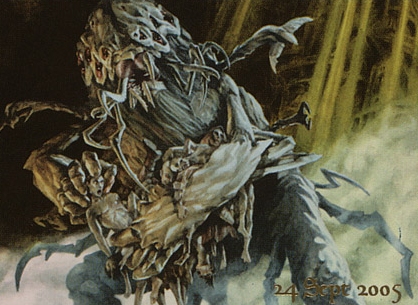A Magic: The Gathering Creature Review by Jonathan Wojcik
So far, these reviews have focused heavily on completely fantastical entities such as living scarecrows, walking fungi and whatever "elementals" are, with the exception of our slug and leech reviews, but those real-world invertebrates are only *slightly* represented in the world of magic. Not so for the class Insecta, which has enough cards out there to make a dozen different flavors of buggy theme decks, and with insects being more or less my favorite thing in the universe, it's probably high time I review my favorites from a game that was once such a huge part of my life...
The Deadly Insect
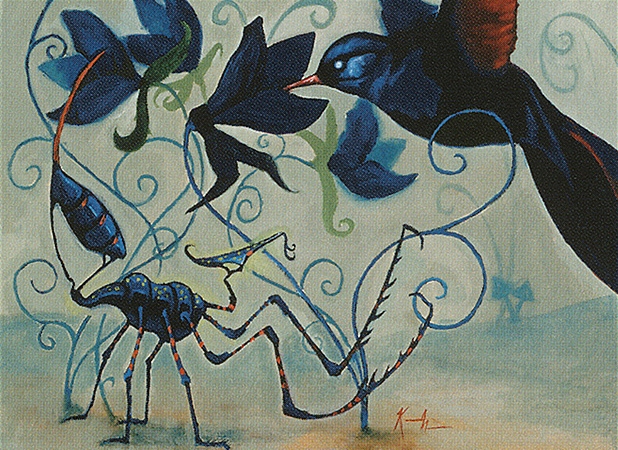
Illustrator: Scott Kirschner
Let's start with the very first insect card I ever ran across, and I believe one of the oldest in the game. The gimmick of this green creature card, for five mana, is that it has immunity to spells and effects - presumably by being so small - and 6/1 stats. That's six damage it can deliver, which is actually on the higher end for this game (remember, a player only starts with 20 life!) but only one it can sustain, implying a small and fragile arthropod with an exceptionally lethal sting.
The design of the insect is just gorgeous. It has thin, mantislike forelegs, a curiously twiggy head and a large, wasplike abdomen that curls upward, like a scorpion. It doesn't fit taxonomically with any actual insect, but combines a lot of sinister looking characteristics into one fantastic beast, and I especially like the way the artwork has it blending in with the surrounding flowers.
The Thelonite Monk
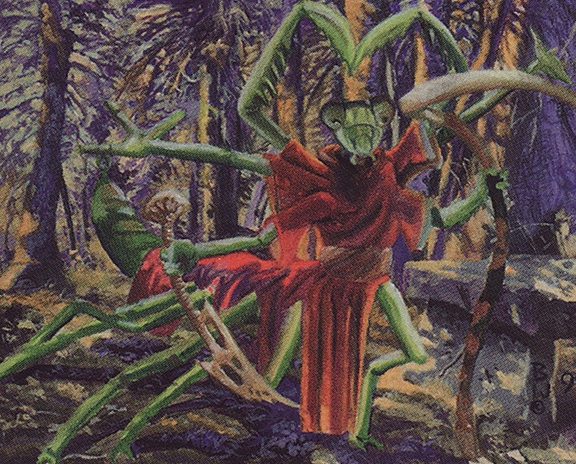
Illustrator: Bryan Wackwitz
Our next "insect" was actually no such thing when it was originally printed as the "cleric" creature type, but has since been retconned, mostly in online play, as a proper insect. Why this particular monk resembles a giant, mutant, twelve-limbed mantis remains unknown, since other "thelonite" cards have resembled humans and elves, and it would be many, many years before the game ever introduced a sapient race of insectoids.
The Thelonite Monk is a little more bloodthirsty than you would expect from the title, too. By ritualistically sacrificing a creature, it can transform any land into a forest!
The Flow of Maggots
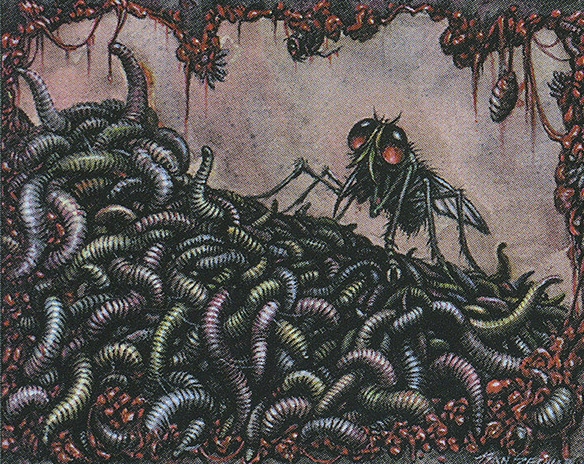
Illustrator: Ron Spencer
Now for a completely realistic insect card, and by one of our favorite illustrators! The Flow of Maggots is exactly what it sounds like, just a whole lot of presumably ordinary maggots, but with a lovely mature fly to complete this beautifully squishy image. Unfortunately not a great card, as it has a "cumulative upkeep" you have to pay every turn and increase every turn if you want to keep it in play, and it's only a 2/2 creature. It's unblockable by all but wall-type creatures, which is nice, but there are definitely cheaper ways to damage your opponent. Still, this was one of my favorite cards as a kid, for the sheer concept of summoning a big wave of fly larvae as a minion.
The Endless Cockroaches
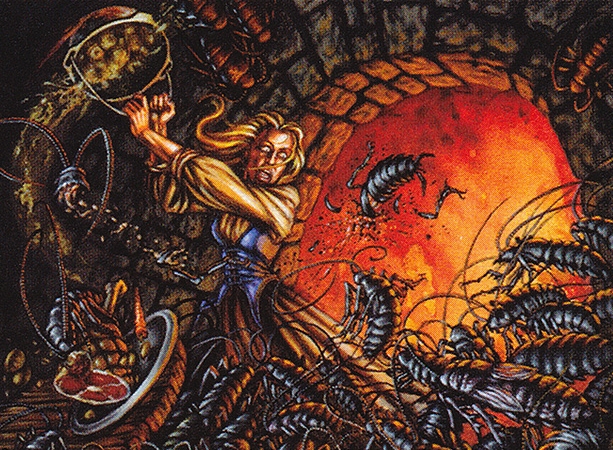
Illustrator: Ron Spencer
Another black insect card by Spencer, the endless cockroaches are definitely handier than the maggots. They may be only 1/1 and cost a whole three mana, but any time they would die, you can put them right back into your hand to play them again the next turn. I love the background colors and the action in this image, as this poor lady tries desperately to defend her dinner from these mostly wingless, chihuahua-sized blattodeans by a fiery glow.
The Acridian
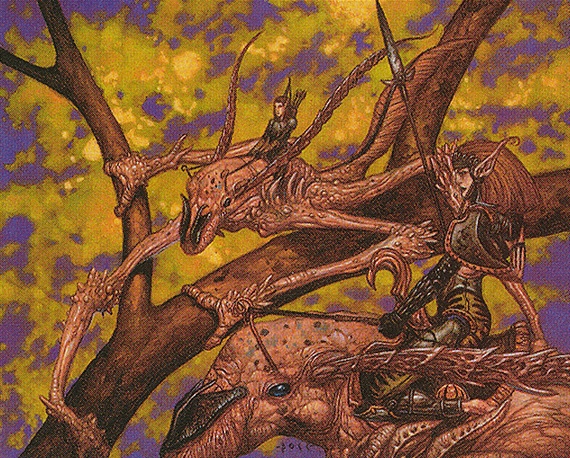
Illustrator: RK Post
This simple green creature is supposedly a huge, arboreal insect trained as a mount by Argothian elves, though it's anatomy is quite a bit more fanficul than just an upscaled arthropod. It has a much fleshier than chitinous appearance, only four long limbs, a featherlike tail and an interestingly bat-like snout. A really unique looking creature, and it's too bad we never saw more of them.
The Shocker
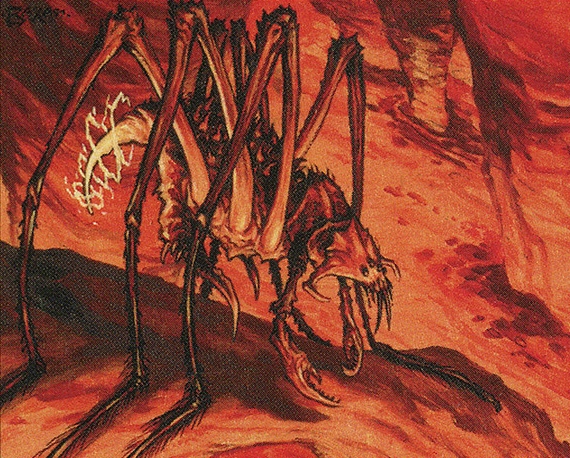
Illustrator: Thomas M Baxa
Our first red-mana insect, the shocker is another 1/1 weenie, but if it manages to damage a player, they have to dump their entire hand into their graveyard and draw a new one, which can easily cost a player some important cards.
We can see that this creature lurks in hot, dry environments, presumably canyons or even volcanic caverns, and capable of delivering a nasty electrical shock from its stinger-like tail. It's also another insect with no real-world equivalent, and doesn't follow the actual anatomy of any arthropoda at all, with a pair of crablike pincers on its thorax and six long, hairy, spider-like legs on what should be the abdomen. I really like those fuzzy fet, and I really like the tapering, toothy face with what appears to be three eyes. Also interesting are the two hooked appendages slung under its body. It looks like it could use those as a big clamping apparatus with its "stinger," doesn't it??
The Moonwing Moth
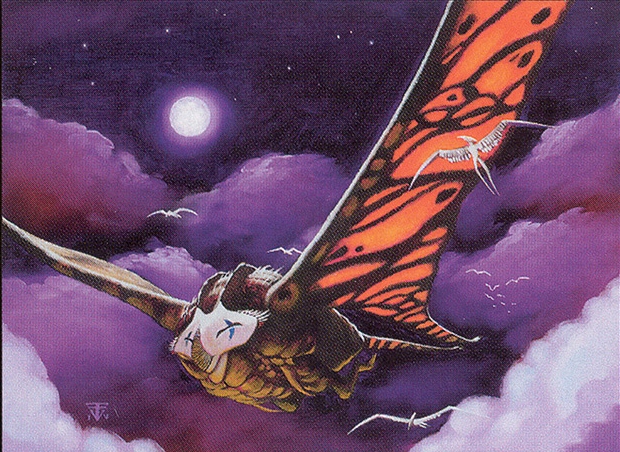
Illustrator: Franz Vohwinkel
Next is our only white insect card, and one of only two in the game. Because white is the most boring color, both of its insects are moths, though the Moonwing at least has a unique and stylish design. Its chunky, scaly body only looks like it has two vertebrate-like legs, and its face is almost like a porcelain mask with squinted, happy eyes. We can also surmise from the birds that this moth is pretty huge, even if it is only 2/1. I guess it can be huge, but still gentle and a little fragile.
The Saber Ants
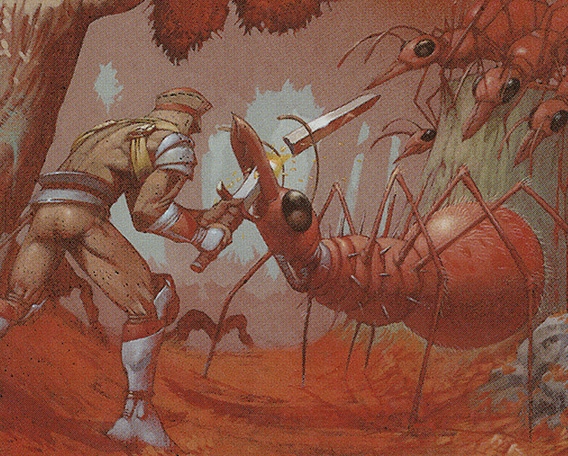
Illustrator: Greg Staples
This green creature generates a 1/1 ant token for every damage it sustains, especially cool if you have a means of saving it from death, pumping up its health, or both!
This illustration is a lot of fun, with the lead ant so easily snapping through that loser's sword and a pack of its fellow workers waiting in the background. The design of these ants is just a little fanciful, with amusing twiggy legs and perfectly round body segments you won't really find in actual insects, but I don't say that as a nitpick. I think these ants have a lot of campy charm, like the kind of stylized ants you might see on the cover of an old pulp magazine or a Hanna Barbera cartoon.
From their large eyes and long, snapping mandibles, the saber ants do match up well with Australian "bulldog ants!"
The Coiling Woodworm
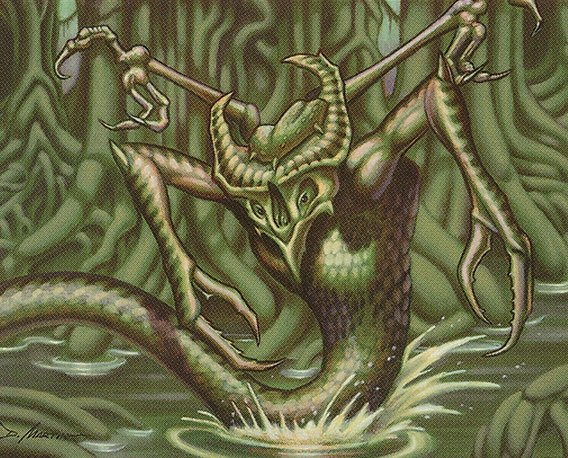
Illustrator: David Martin
Speaking of fantastical anatomy, this green creature doesn't look even slightly like an insect, a worm, or basically anything on Earth, and that's fine, because what we have here is some sort of snake-frog-crab with a face that isn't sure if it wants to look more like a fruit bat or like an owl's skull. WHATEVER the heck a Coiling Woodworm is supposed to be, it's just cool as hell, and the fact that this absurd thing is considered an "insect" really only makes it all the cooler.
The Giant Caterpillar
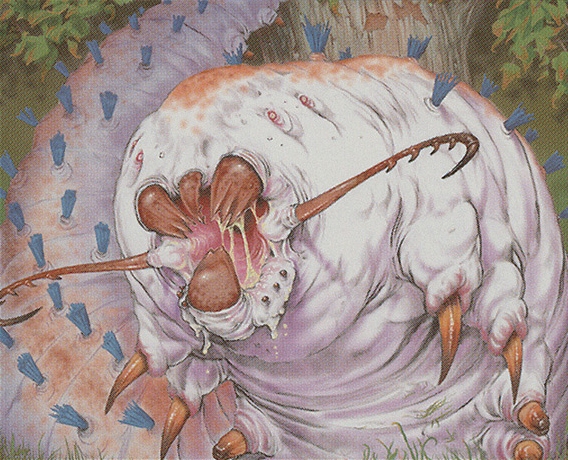
Illustrator: Arnie Swekel
There's a couple different illustrations of the giant caterpillar, but this one is my favorite. I really like those jagged mouthparts, barbed hooks, and multiple beady little eyes in this fleshy, pallid beast. It has a lot of personality, and what's really fun is that whenever this creature dies, you get a flying butterfly token!
The Duct Crawler
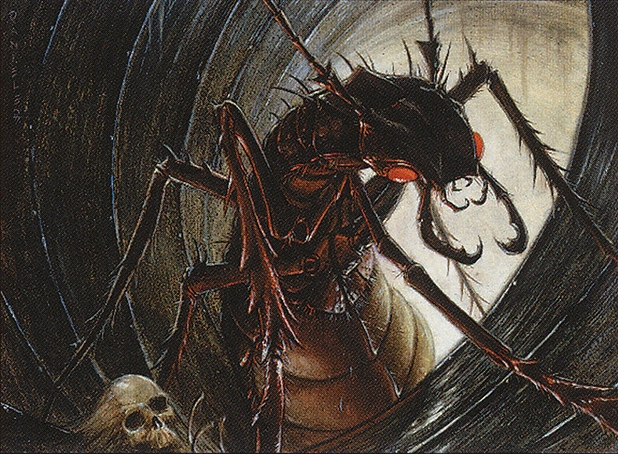
Illustrator: Stephen Daniele
Another red one, this simple 1/1 for one mana includes the option to pay two mana and prevent any enemy creature from blocking its attacks. I guess this means you expended some extra resources to find the duct crawler another duct it could sneak through, or something.
This creature follows insect anatomy more accurately than almost anything on this page, but still doesn't represent any one obvious insect. It's a very generalized, basal looking creature, perhaps some kind of wingless beetle, or even something related to an earwig. Whatever the case, I love the duct crawler's overall spininess and the lighting of this image. Judging by that skull, this thing is also at least seven or eight feet in length, isn't it? Really ought to be more than a 1/1, I'd think.
The Plague Fiend
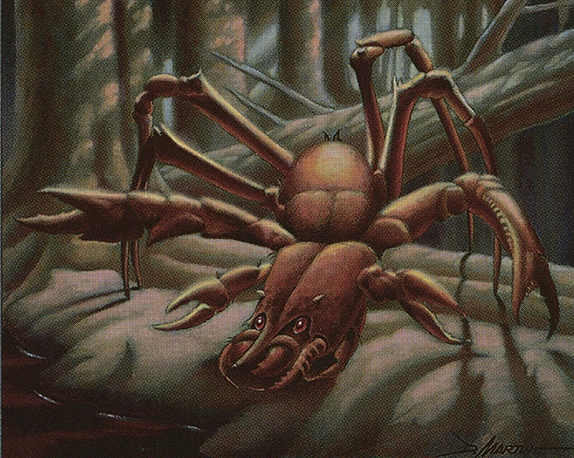
Illustrator: David Martin
This simple 1/1 black insect destroys any creature it damages unless that creature's controller pays two extra mana. I suppose that represents getting the victim some prompt medical attention, if the plague fiend is as filthy and virulent as it sounds. For whatever reason, this is probably one of my favorite insect designs in magic, almost like a Solifugid or "camel spider" crossed with a termite, and I think it's those cute little beady eyes that really win me over.
The Giant Mantis
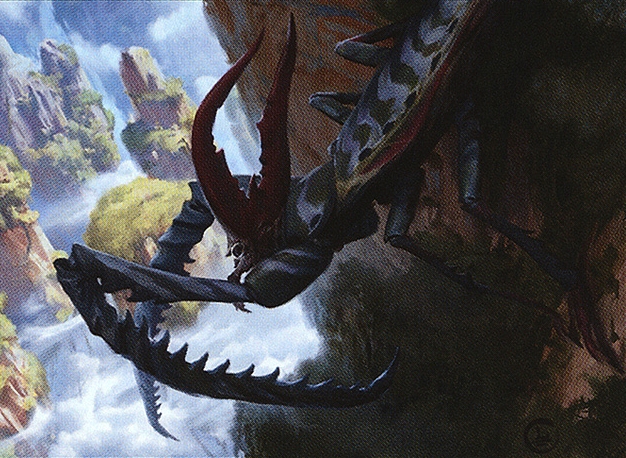
Illustrator: Lake Hurwitz
An older print of this card simply features a big, green mantis capturing a pegasus for dinner, which is funny, but Lake's mantis has SUCH a cool design, with an almost skeletal looking face and huge, curving red "horns!" It's too bad that the legs here look so attached to the abdomen, because it looks like our artist otherwise made a pretty strong attempt to follow the details of some actual mantodea, not completely going for a nonsense bug-monster like many of these other pieces.
The Rust Tick
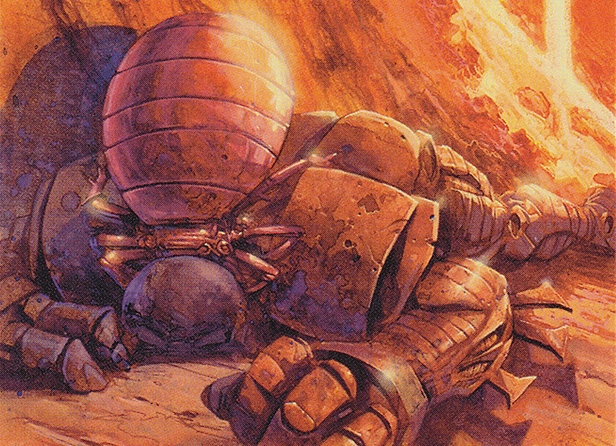
Illustrator: Carl Critchlow
There are several decent artifact creature insects in Magic, but I think the most interesting is this parasite capable of indefinitely disabling a single enemy artifact creature, presumably feeding on metallic beings and corroding them in the process! As a mechanical entity itself, it doesn't need to look anything like a real animal, but what it DOES look like is more of a big bedbug than a tick!
The Lithophage
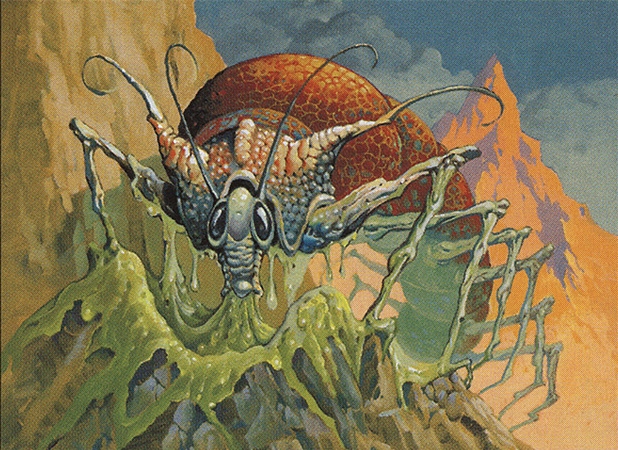
Illustrator: Mike Ploog
At 7/7 for five mana, this red creature has some pretty hefty stats for a steal of a price....if you can afford to keep it in play by sacrificing an entire mountain every turn. Just how big IS a lithophage!? It's an awesome design, too, I adore any creature with a hoselike face as well as any creature with big, sorrowful bubble-eyes, and both look great on this many-legged worm as it messily guzzles up a heap of half-melted stone.
I also like that second set of antennae sprouting from the segmented, conical turrets on the creature's pebbly thorax. So many good shapes and textures to a Lithophage!
The Giant Cockroach
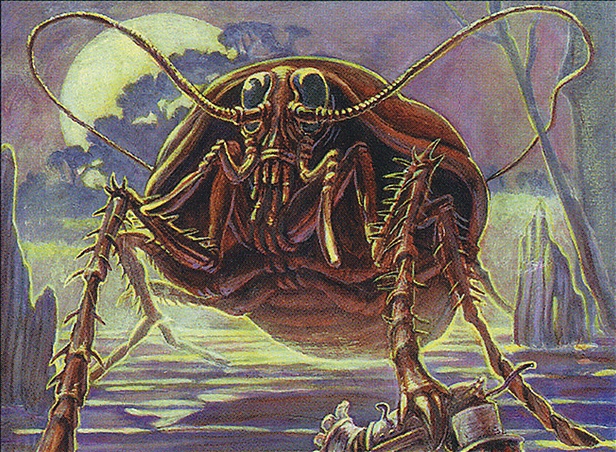
Illustrator: Heather Hudson
One of the only other roach cards in the game, and painted by one of my other favorite artists, who also gave us my favorite Thorn Thallid! Her cockroach even has a similar overall feel to thorny, with its hunched body dominating much of the image and a similar quality to its eyes and face, while still getting the body plan of an actual cockroach down almost flawlessly. This might be one of the finest looking insects ever painted for a magic card.
The Mind Maggots
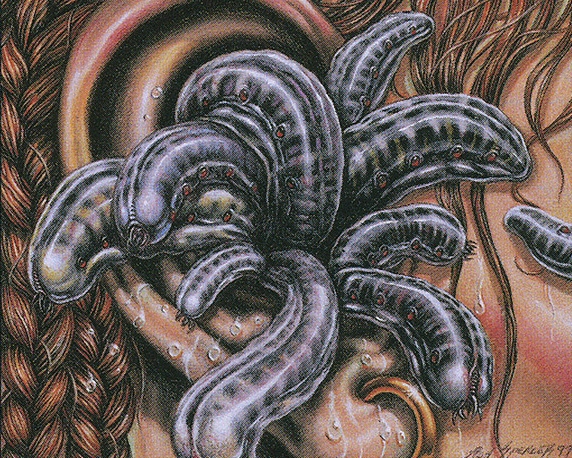
Illustrator: Ron Spencer
Going right back to Ron Spencer again, these slimy parasites compensate nicely for the disappointment that was Flow of Maggots, being an almost halfway decent card that starts at 2/2 and can gain an additional +2/+2 for each creature card you discard from your hand when the maggots are first played. The image of them spewing from the ear of what looks like an otherwise fairly normal, well-groomed person is definitely one of the more grotesque things you'll see in this game, but the maggots themselves are fairly cute. The red nodules down their sides look like they're meant to be eyes, which I'm fully willing to accept for a species of magical brain parasite.
The Plague Beetle
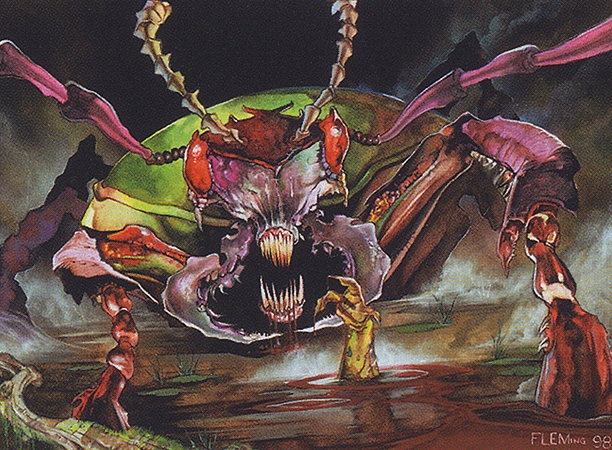
Illustrator: Tom Fleming
Nothing but a 1/1 creature for one black mana, with the "swampwalk" ability, making it unblockable if the opponent controls any swamps. For such a simple creature, it's a very dramatic image, with some wild colors on this drooling, demon-fanged, four-antennae'd beetle. Like the duct crawler, it's also another 1/1 insect that seems to be huge.
This plague beetle's original flavor text was "It is the harbinger of disease, not the carrier," so unlike our earlier Plague Fiend, you won't necessarily contract any noteworthy diseases from this thing's bite, though it can't very well be all that sanitary either way.
Later, an alternate plague beetle was illustrated by Matt Cavotta, and while not nearly as monstrous and ominous as Fleming's, it's hard for me to pick a favorite between the two. Cavotta's beetle has a more muted but very pleasing color scheme, and the ribbed shape of its shell is very nicely done! There's no hope of realistically identifying some of the creatures we've seen on this page, but I think I'd peg this one for some sort of large darkling or carabid beetle.
The Brain Weevil
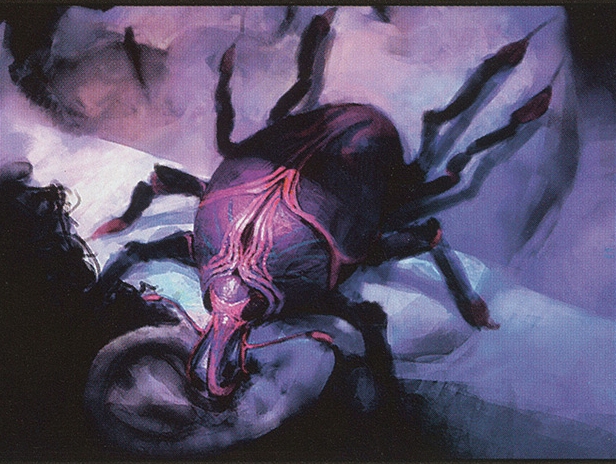
Illustrator: Anthony Jones
Another ear-loving mind parasite! Brain Weevil is a fairly decent weevil, even if it inexplicably possesses eight legs. I like its pink and purple folds and wrinkles, really looking like something that goes after brain matter.
The Fretwork Colony
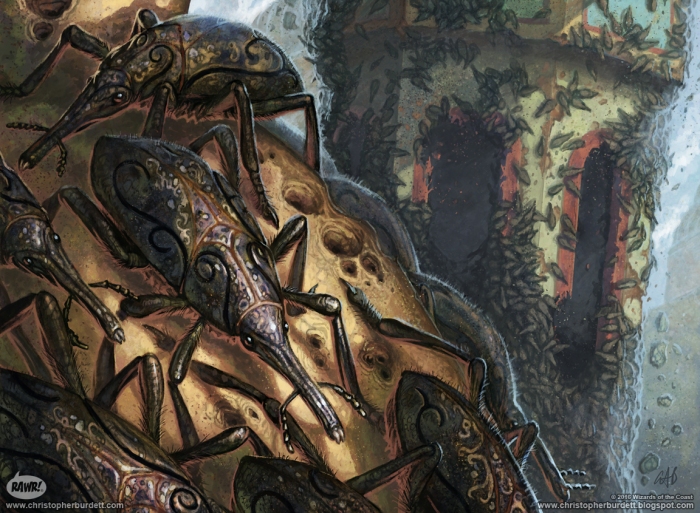
Illustrator: Christopher Burdett
More weevils! They certainly were missing from Magic's selection, despite being the largest group of beetles and therefore the largest single family or superfamily of animals in the world.
This black creature apparently represents a horde of wood-boring weevils, known for leaving intricate patterns behind as they feed. Starting at 1/1, they gain a permanent +1/+1 each turn, but also deal one damage to their controller, so I guess they keep multiplying and might possibly bite more than the surrounding architecture.
The Pestilent Souleater
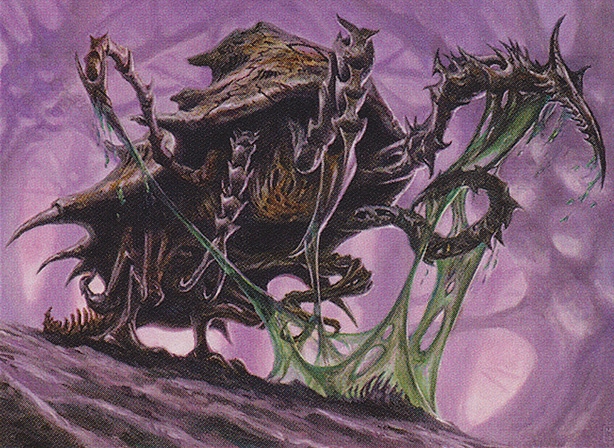
Illustrator: Matt Stewart
Our second artifact-based insect, this beautifully barbed monstrosity hails from Phyrexia, which we've talked about a little in our Zombie and Horror reviews, but may soon be exploring in its own dedicated entry.
I'm not sure exactly how this thing eats souls, but by spending two life, you can make it venomous or "infectious" until the end of the turn. I really love how tick-like its appendages are, while its back is more of an exaggerated horseshoe crab with a prickly tail.
The Carrion Beetles
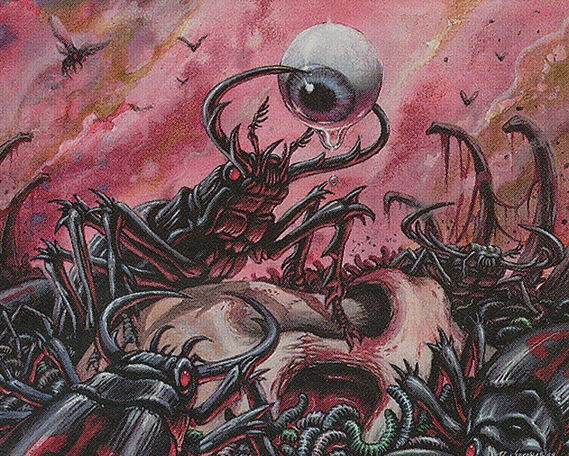
Illustrator: Ron Spencer
Our last Ron Spencer insect, there's not a whole lot to say about the carrion beetles except that, once again, Ron paints us a beautifully colorful image of gore and decay. Where did that beetle even get such a fresh, glistening eyeball when the rest of their meal looks so putrid and far gone? Really love the pink and purple haze of the background, too.
The Heartstabber Mosquito
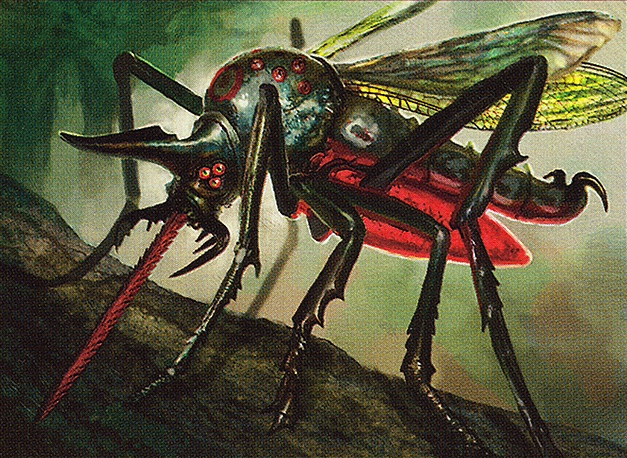
Illustrator: Jason Felix
A lot of strange, strange things about this giant "mosquito." It has twice as many wings as it should, a set of mandibles you won't find on any Diptera, a beetle-like horn, an entire second abdomen filled with blood, and a multidude of red eyes on both its face and its thorax. A pretty neat monster, which for an extra cost can insta-kill any other creature as soon as it enters play!
The Mortician Beetle
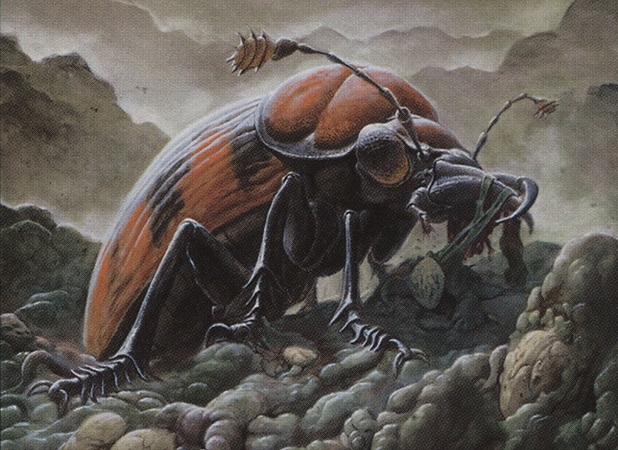
Illustrator: Lars Grant-West
Insects in magic are traditionally associated with green, but the majority of our entries have now been black. I guess black just has the cooler selection, including this highly accurate burying beetle! These are the beetles which, in the real world, will work together as a mated pair to bury an entire small animal corpse. It might have been nice if they based a card mechanic on that, but what they did give us was a 1/1 beetle that grows by another 1/1 every time a player sacrifices one of their own creatures. In this case, the huge size of the insect in the portrait makes a little more sense, assuming the beetle really physically gets larger by this process.
The Phyrexian Battleflies
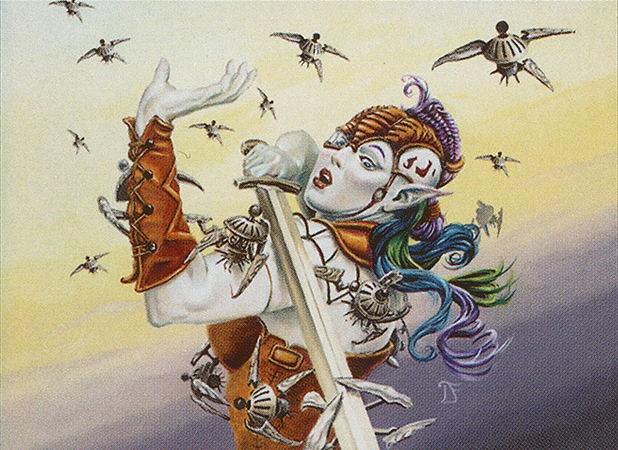
Illustrator: Dan Frazier
Another Phyrexian entry, and these apparently some sort of manufactured bioweapon. I enjoy how abstract these creatures are, apparently considered insects but resembling pinwheel-like metallic constructs, their three "wings" also functioning as legs, and a simple ball of spines serving as their attack mechanism.
The Living Hive
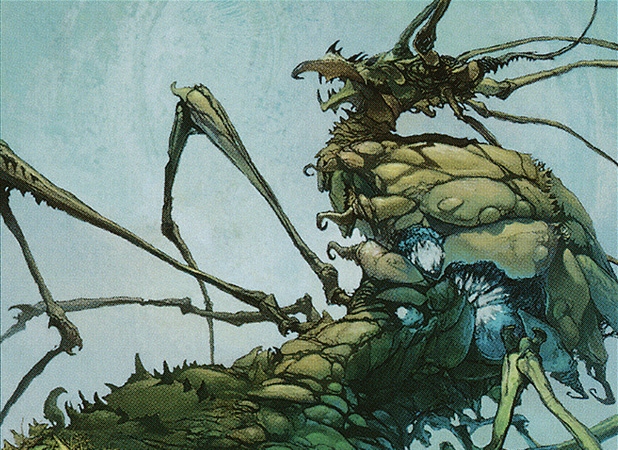
Illustrator: Anthony S. Waters
We've moved this one over from the "elementals" review, because every insect belongs with its family! Always! So, this is both an insect and an "elemental," and represents a magically animate hive of many, many tiny insects it generates as tokens. I love the surreal, dreamlike nature of this design, blending an armor-plated, insectlike being with a part of the landscape. To me at least, its body appears to be formed from a mix of insect chitin, fungi, soil and stone, a truly "elemental" embodiment of an insect nest.
The Swarm of Bloodflies
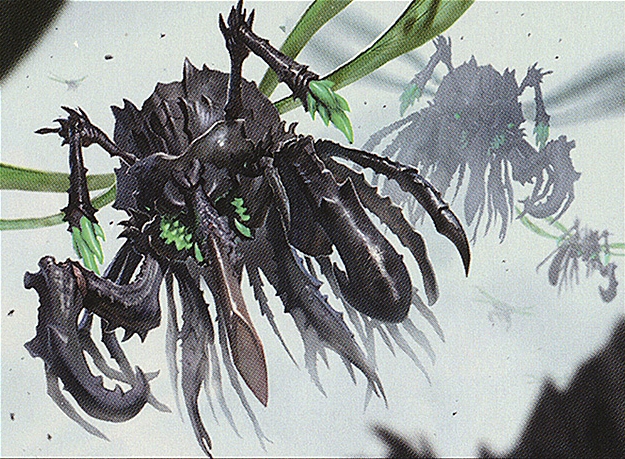
Illustrator: Marco Nelor
Very cool, very menacing looking "flies," probably closer to wasps or even neuroptera given their number of wings, and with the interesting combination of both a needle-like proboscis and jagged, chewing mouthparts. These insects gain an automatic +1/+1 counter every time any other creature dies, for any reason, making them an even nastier version of the mortician beetle...and of course, they can fly!
I have to say, though, I think these designs would have looked better with eyes. Nice, big, shiny black or glowing green fly-eyes.
The Invader Parasite
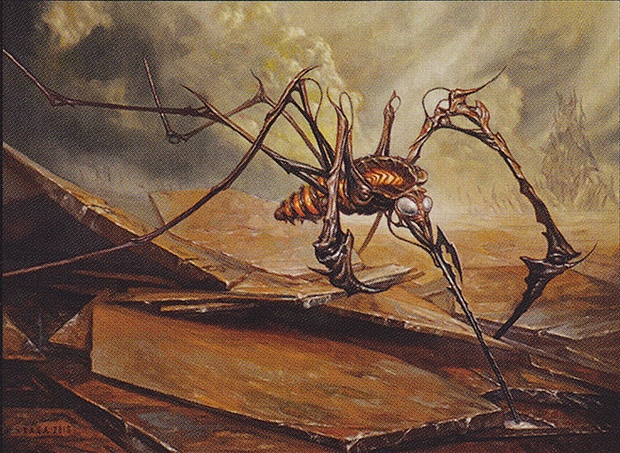
Illustrator: Volkan Baga
This 3/2 red insect allows you to "exile" a single land card when it enters play. Then, whenever an opponent plays the same type of land, they suffer two damage from the parasite. Not bad I guess, but it's hard to figure out exactly how this translates to "parasitism," exactly. It's still one of the coolest looking insects in the game, like a long-legged, wingless mosquito with a lot of alien, biomechanical details that feels as if they ought to be tied in with Phyrexia.
The Wirewood Symbiote
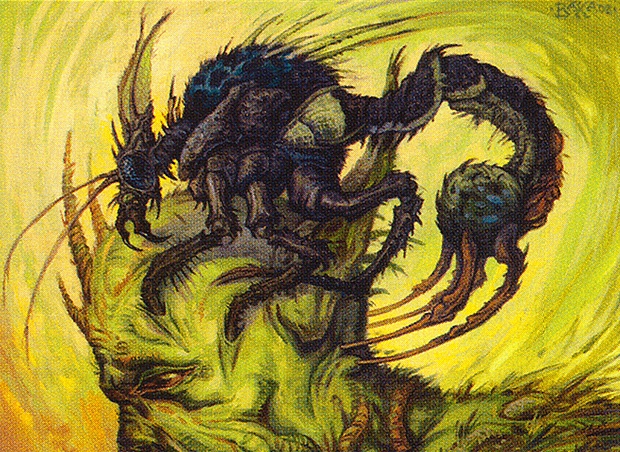
Illustrator: Thomas M Baxa
This was probably conceived under the common misconception that a "symbiote" is the beneficial counterpart to a "parasite," when calling either one a "symbiote" is still scientifically accurate. Resembling some extreme distortion of a scorpionfly with way more barbs, spines and hairs, I think this might be another of my all-time favorite of magic's insect designs, and I think a lot of that is thanks to the face. If you can't tell by now, the eyes are often my favorite feature of arthropoda, and I especially love the big, wide, round eyes that make so many insects look so alien, yet so innocent at the same time.
Wirewood symbiote unfortunately only interacts with elves, allowing you to return an elf card to your hand in order to untap any other creature, which its flavor text describes as "drinking fatigue." I am never going to have any reason to make a magic deck with an elf in it, so I'm afraid I'm never going to have much of a use for this cutie.
The symbiote did, at some point, get a reprint with a fancy new illustration, this time by Yohann Schepacz. I still love Baxa's fly-eyed critter the most, but this take is an interesting and cool design in its own right, a neat little pal that hangs out less conspicuously on its elf friend and injects them with the feel-good juice through those pretty, yellow glands on its arms.
The Gleancrawler
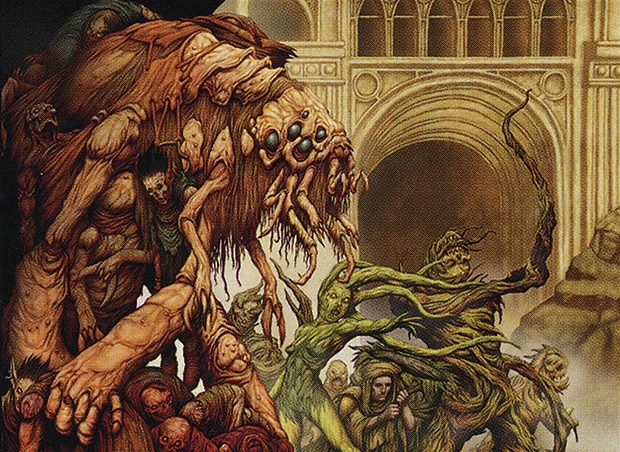
Illustrator: Dave Allsop
We're moving this one over from our horrors review, so I'll be repeating some of what I originally said there. This insect horror is both a black card and a green card, and it represents the pinnacle of monsters associated with a wonderful group known as the Golgari, one of many guilds in the massive city of Ravnica.
The Golgari are associated with insects, fungi, plants, oozes, disease and undeath, but aren't the villains you might expect from a such a motif in any other setting. They're more like the city's unseen clean-up crew, maintaining the cycle of decomposition and rejuvenation and even providing food for the city's poor and downtrodden.
Any creature that dies while the Gleancrawler is in play will return to its owner's hand, rather than the graveyard, so it seems this giant insect collects the dead for resurrection by the Golgari, or even carries some sort of necromantic agent itself.
The design here is also just amazing. It looks very, very much like an enormous flea, one of my favorite arthropods, but with a lot of extra eyes and claws and long, shaggy fur giving the whole thing a sort of hunched, shambling sloth-like appearance. Look at the foremost set of eyes, and it almost appears to be scowling. To me, there's a gentle and mournful personality behind those scattered eyes, reminiscent of the Ohmu from Nausicaa. A powerful and dangerous monster, but not really a malevolent one.
Similar can be said of the second Gleancrawler illustration by Jeremy Jarvis. Not quite as magnificent of a bug, but the way it carries the dead around by the armful looks really innocent, almost child-like to me. It's just doing its job!
The Nantuko Disciple
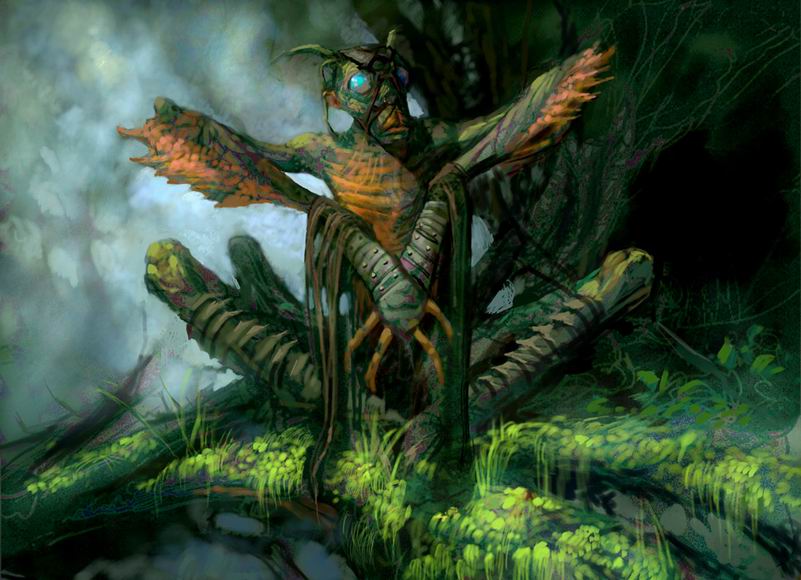
Illustrator: Justin Sweet
I mentioned earlier that Magic would eventually have a proper "insect race," and these are known as the Nantuko. I'm sharing the Disciple because I think it's the best looking illustration of a living, healthy specimen, but unfortunately, I'm just not that big a fan of their stretched-out, quasi-human faces. I guess it's probably supposed to make them more relatable and appealing, but a full-blown mantis face would have had a lot more personality, looked overall more badass, and we would have finally known what the Thelonite Monk really was!
A noble effort, but not one of my favorite races in the game; just something I thought bore some mention here.
The Kraul Warrior
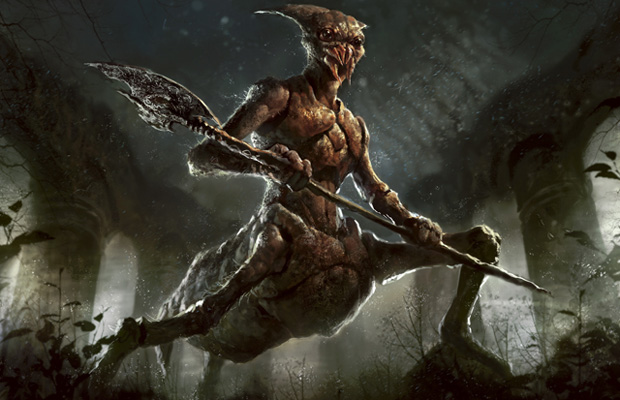
Illustrator: David Rapoza
This, on the other hand, is a VERY charming bug-person, even if its face feels like it cribs a little bit from those District 9 aliens. Unfortunately, this is one of only two Kraul cards ever made, so they never became the major presence the Nantuko were.
Mazirek, Kraul Death Priest
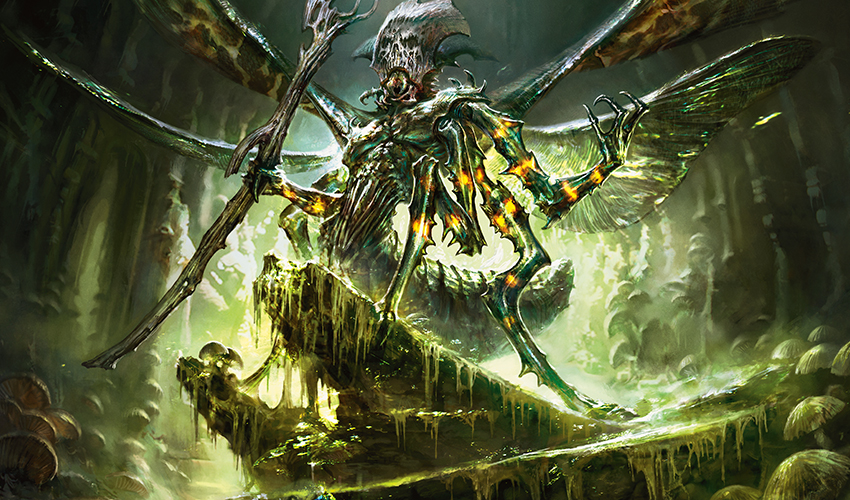
Illustrator: Mathias Kollros
Good news, though; that one other Kraul card is the game's first true legendary insect character, and his ability isn't bad at all. Whenever any player sacrifices any creature, Mazirek allows you to put a +1/+1 counter on every creature you control.
There's also an official short fiction story involving Kraul, where we unfortunately learn that even the humanitarian Golgari have some prejudices against his people.
As a design, Mazirek doesn't look a whole lot like the other Kraul we've seen, but that's just a bonus. It implies that if we ever got more of these guys, they might not be strictly limited to one rigid model sheet. He has a pretty awesome locust-like look to him, with the illusion of a human skull in the pits and ridges of his eyeless head-shield, and you'll notice that despite a rather humanoid stance, all of his limbs are correctly attached at the thorax. He's not anthropomorphic at all! He just looks that way when he rears upright!
The Delver of Secrets
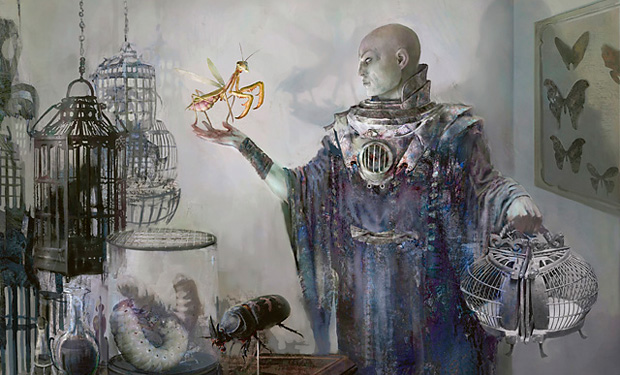
Illustrator: Nils Hamm
While there are dozens more insect cards we could go over, we're going to end this on one of the most unusual and interesting, as well as the only line of blue insects.
It all begins with this 1/1 human wizard, seemingly studying something to do with insects as they pertain to the secrets of magic. This debuted in the same set of cards that introduced "transforming," double-sided cards, and allows you to look at the top card of your deck once per turn. If the card revealed is an instant or sorcery (a magical spell of some sort), you get to glip this card over into....
The Insectile Aberration
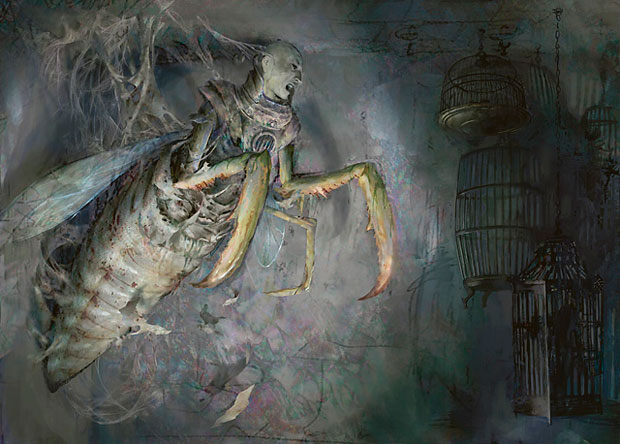
Whoops! I guess they delved too deep into whatever it was they were delving! It's Magic: The Gathering's retelling of The Fly, but with a bit of preying mantis thrown in there for good measure. It's not a 3/2 "human insect" with flying, and it doesn't end there!
The Aberrant Researcher
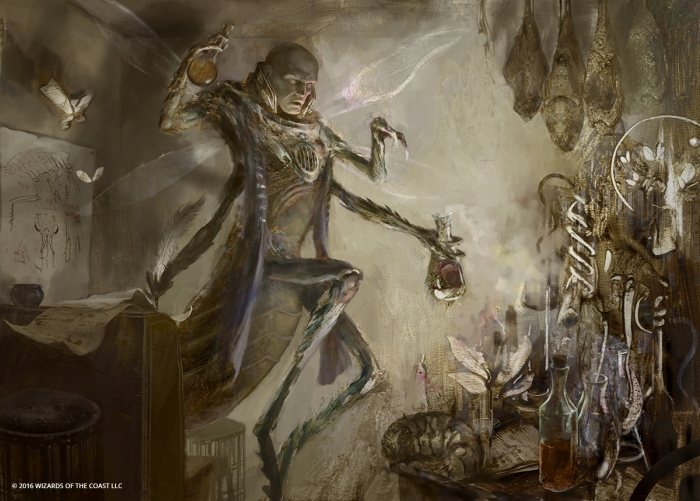
In a later set, we find that the researcher has adjusted fairly well to the life of a big wasp person, apparently trading the mantis arms for proper hands and only continuing their studies. This time, you take the top card from your deck and put it into your graveyard each turn, indicating rather more destructive research than it conducted in its human form. Once again, an instant or sorcery uncovered this way will transform the card, this time into...
The Perfect Form
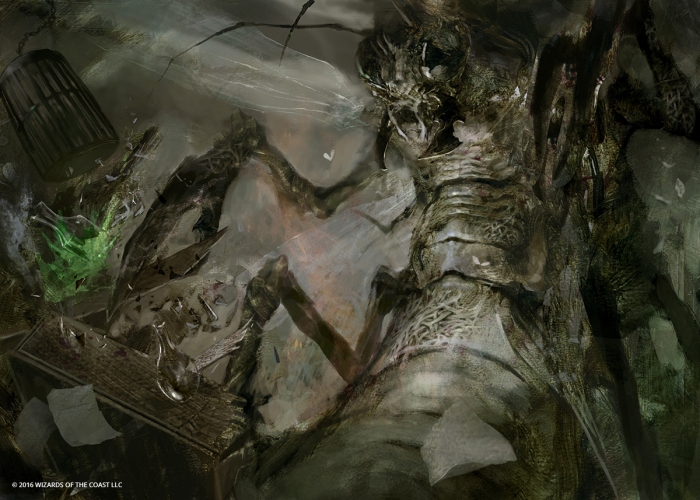
Now an insect horror, our hero has finally gotten rid of that pesky human head and torso, becoming the full-blown giant insect he was always meant to be! Lovely flavor text, too:
"The final pages of the experiment log were blank. Investigators found it abandoned on a desk in the researcher's lab, open, the pages flipping in the wind from a shattered window."
The Docent of Perfection
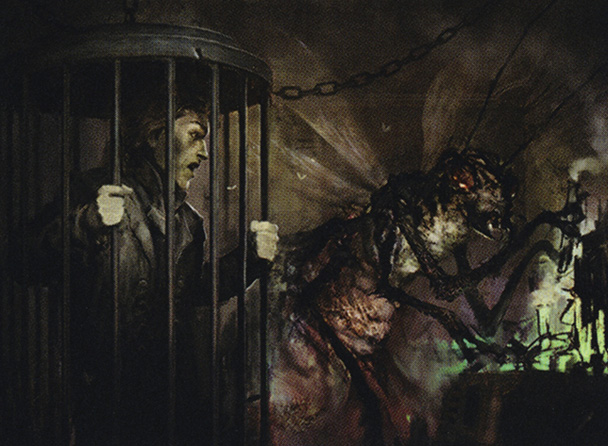
Later still, we revisit the magical mutant to find him busier than ever, still an insect horror, still a mad scientist, now capturing humans for its nefarious experiments! This card creates a 1/1 human wizard every time you cast a spell, and once you have three or more wizards in play, you can transform the docent intooooo.....
The Final Iteration
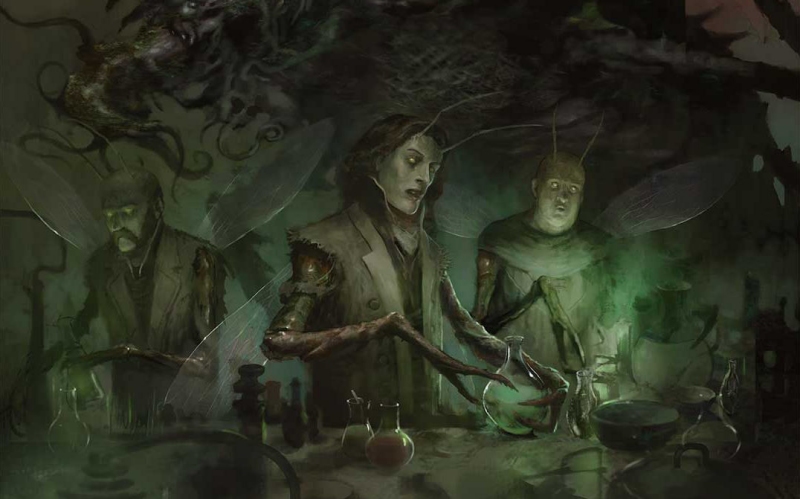
Beautiful. Our friend has become something even more alien than a mere insect-human hybrid, a tentacled monstrosity looming partially unseen in the background as its mutant students toil diligently under its control. This card continues to generate wizards, but also gives all wizards +2/+1 and the ability to fly.
What's more, the being has graduated from an insect horror to an Eldrazi insect. What are the "Eldrazi" you may wonder?
Eldrazi are more or less the most "alien" creatures introduced to magic continuity, and I'm probably obligated to give them a review sooner or later, even if, admittedly, I'm not quite as into them as any of the other creature types I've reviewed. They're a pretty interesting concept, however, apparently representing only the visible "pieces" of far vaster, far stranger entities, which means our persistent entomologist up there may have just been basically absorbed into another creature...unless, perhaps, he's only the beginning of an entirely new one, an all-insectoid Eldrazi strain.
...Conversely, are we to surmise that insects had something to do with the Eldrazi all along? It was presumably quite a big "secret," of some sort, that our "delver" uncovered in their entomological research, and just look at the outcome!



